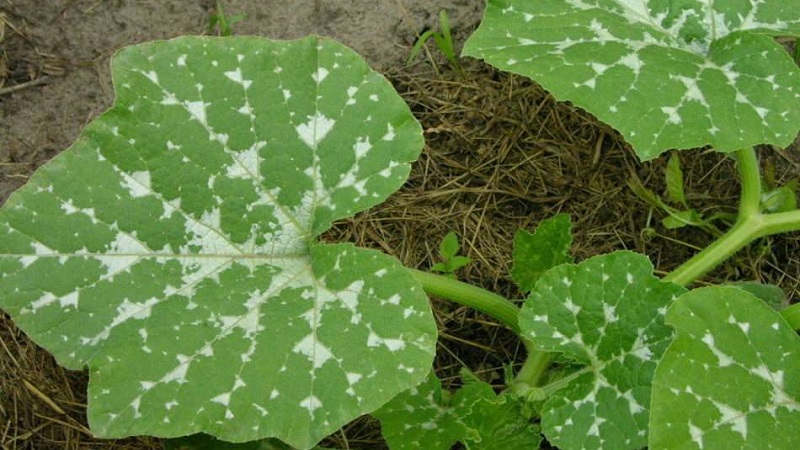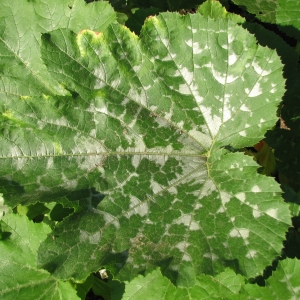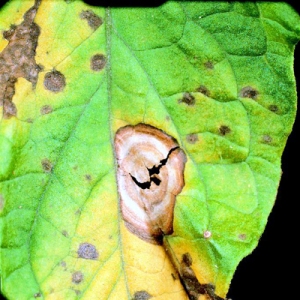How to detect pumpkin diseases in time, effectively cure them and save your harvest
Pumpkin - unpretentious and fruitful culture. Plant care is simple, it consists of timely watering, fertilization and molding. But even if all the rules are followed, the pumpkin can get sick with a virus or fungus, which reduces the quality and quantity of the crop. The causes of diseases are different: high humidity, untimely feeding, infected seeds.
In the article, we will consider the most common diseases of culture, we will find out methods of treatment and preventive measures.
The content of the article
Pumpkin diseases and their treatment
Pumpkin diseases occur both in the open field and in greenhouse conditions. Some appear at an early stage of development, others arise during the fruiting period. We will answer the questions why the leaves dry or turn yellow and what to do if the bushes get sick.
Root rot
Root rot affects seedlings or young bushes outdoors. The roots turn brown, the leaves become dry and yellow. Reasons for the appearance of root rot: watering with cold water, sudden temperature changes, increased soil acidity.
For preventive purposes, it is recommended to follow the rules of crop rotation - to plant pumpkins after potatoes or peppers, and also thoroughly disinfect the soil. If root rot has already formed, the bushes are sprayed with a solution based on zinc sulfate or Bordeaux liquid. Before processing the beds, be sure to wear a respirator, glasses and gloves.
Important! To lower the acidity of the soil, liming is carried out before planting: sprinkle the soil with a mixture of lime and dry wood ash. The components are used in equal proportions.
Powdery mildew
White spots appear on the leaves, which eventually grow throughout the plant. The causes of infection lie in weeds and soil, as well as in an overabundance of nitrogen-containing dressings.
The fungus is carried from plant to plant by water or wind. As a preventive measure, they regularly loosen the ground and remove weeds. For the treatment of powdery mildew, ground sulfur or an infusion based on mullein is used. The procedure is performed early in the morning to avoid burns.
Peronosporosis
Peronosporosis is a downy mildew. Yellow-brown spots appear on the leaves, the plant dries out. Insect pests contribute to the rapid spread of the fungus: aphids, whiteflies, slugs. To avoid false dew, the beds are carefully dug up before planting, all the debris and the remains of last year's plants are burned. For disinfection of the earth, the preparations "Gamair", "Fitosporin" are used.
It is not recommended to plant pumpkin bushes close to each other, this can lead to a number of problems. If peronosporosis appears on the bushes, it is advised to immediately treat the beds with a solution of copper sulfate or Planzir. It is important to detect the disease in time and take protective measures as early as possible.

Anthracnose (copperhead)
Dark brown spots appear on the leaves, their diameter varies from 2 to 12 mm. Copperhead occurs due to the transferred frost, sunburn, frostbite. If you do not provide assistance in time, the spots grow and merge into a single pattern. Ulcers appear on the stems, which dry out and crack over time. As a result, the plant dries up, the pumpkins lose their firmness and elasticity.
For prevention, it is advised to fertilize the soil with potash-phosphorus fertilizers and plant weather-sensitive varieties in greenhouses. As therapeutic measures, the means "Previkur" or "Fundazol" are used. Before use, study the manufacturer's recommendations and the required dosage.
Important! When grown in a greenhouse, the structure must be ventilated and the irrigation regime must be observed. Excess water and high humidity form a special microflora, which serves as an excellent soil for the development of copperhead.
Green spot
Green spotting with raindrops and winds is transferred. The disease develops in the second half of summer, closer to harvesting. Light green or brown spots appear on the pumpkins, which provoke cracking of the peel.
For the purpose of prevention, varieties resistant to diseases are chosen, and they are planted in seedlings. Before planting, the largest and heaviest seeds are selected, disinfected with a solution of potassium permanganate or aloe juice. It will not be superfluous to harden the material, for which disinfected sunflower seeds placed in a freezer for 2-3 hours for 5 days. If the pumpkin is nevertheless infected with green spot, it is treated with a solution of Bordeaux liquid or Alirin-B.

Yellow mosaic
On young plants, the disease manifests itself in the form of twisting and white color, on adult bushes - yellow patterned spots. When infected, the bush and fruits stop growing, the plant takes on a painful appearance.
Yellow mosaic is transmitted through soil or insect pests, including whitefly or aphids. Experienced summer residents advise, if possible, plant disease-resistant varieties. As a preventive measure, they follow the rules of care, regularly water and fertilize the beds. Treat yellow mosaic with karbofos solution.
Important! If the disease has overtaken the greenhouse pumpkin, immediately after harvesting, 10 cm of the topsoil is removed. After that, the soil and the greenhouse itself are treated with a 0.5% solution of trisodium phosphate. Gardeners recommend boiling the clothes in which the procedure was carried out several times. The mosaic virus can stay on it for up to two years.
Sclerotinia
Sclerotinia, or as it is more commonly called, white rot, appears on both young shoots and mature plants. It multiplies with the help of fungal spores, which are especially active in hot and rainy times. When damaged, the petioles and leaves begin to rot. A mycelium appears near the base of the stem - a white dense bloom that looks like a fluff.
If found, the affected areas are sprinkled with dry charcoal or ash. As a preventive measure, top dressing with zinc sulfate, urea or copper sulfate is used. Sclerotinia is especially active in greenhouse conditions and greenhouses.
Bacteriosis
One of the most common and dangerous cultural diseases. Brown sores appear on the leaves, which provoke dryness and wilting. Soon, the fruits themselves are deformed and take on an ugly shape. Seeds and residues of vegetation in the beds were recognized as the source of bacteriosis. Frequent rains and watering with cold water accelerate the development of the disease.
If found, the infected fruit is immediately plucked and buried as far as possible from the garden plot. For further prevention, the bushes are treated with a mixture of lime and copper sulfate.
Fusarium wilting
When infected, the root system weakens, the stems become thin. In places of defeat, a white-pink bloom is observed. In dry summers, the leaves turn yellow and dry out. Dangerous bacteria penetrate through the root, with water they spread throughout the bush.
As a preventive measure at the seedling stage, the seeds are watered with a growth stimulator "Kornevin" and sprayed with a solution of milk and iodine. For treatment, drugs "Quadris" or "Kurzat" are used.
Alternaria
Dry black spot is typical for mature and large fruits.Dark and dry spots appear on the pumpkins, which slowly turn into a velvety crust on the surface of the vegetable. Alternaria also appears on fruits that have already been removed from the garden. The pumpkin dries up due to violations of the assembly and storage conditions.
To prevent it, it is advised to wipe vegetables with a dry cloth and store the crop in a dark, dry and well-ventilated place. Summer residents regularly examine vegetables for signs of infection, painful fruits are immediately removed.
Symptoms and what they talk about
Spots, pustules, plaque - all these signs indicate that the vegetable is lacking or oversupply in nutrition or care.
Consider the common symptoms that signal the onset of disease:
 White spots or white bloom are a sign of an overabundance of dressings, especially mineral ones. Powdery mildew or fusarium wilting occurs due to the appearance of spots.
White spots or white bloom are a sign of an overabundance of dressings, especially mineral ones. Powdery mildew or fusarium wilting occurs due to the appearance of spots.- Bushes wither due to sharp climate changes, non-observance of the rules of crop rotation. The most likely diseases with such symptoms are root rot and copperhead.
- Fruit deformation is the main symptom of bacteriosis. The fruits acquire a diseased form, uncharacteristic for the variety, become weak and soft.
- Mold on the fruit indicates that the plant is experiencing an excess of moisture. A defect appears due to green or brown spotting.
- Yellow patterns on the leaves are the main sign of yellow mosaic. If found, it is necessary to treat the pumpkin with Bordeaux liquid or an ash solution. Photos of diseased leaves clearly demonstrate the external signs of the disease. (photo 4)
- Pustules on the roots signal that the plant is sick with root rot or fusarium wilt. This is due to improper disinfection of seeds and soil.
Preventive measures
Disease prevention is an important step in plant care. It is she who allows you to save the harvest and collect the most delicious and juicy pumpkins from the beds.
 Gardeners identify the following protective measures:
Gardeners identify the following protective measures:
- Compliance with the rules of crop rotation. On the same bed, it is not advised to plant a crop for more than two to three years in a row. The best precursors for pumpkin are greens or legumes, the worst are squash, squash and eggplant.
- Disinfection of garden tools, clothing, seeds and soil. The best disinfectants: Bordeaux solution, potassium permanganate, "HOM".
- Growing and preparing seedlings: timely sowing, adherence to the rules of watering and feeding. It will not be superfluous to harden the seedlings.
- Proper plant care, including regular weeding and loosening of the soil.
- Organization of root and foliar feeding. Milk whey, iodine, and onion solution perfectly protect against diseases.
- Regular inspection of the bushes for external damage.
- Timely measures for the treatment of plants.
Pumpkin pests and methods of dealing with them
Among insects, melon aphids are distinguished. Small, translucent beetles settle on the back of the leaf. It feeds on aphids with plant sap, which causes metabolic disorders. The leaves dry and curl, after which the flowers and ovaries fall off. If measures are not taken in time, the plant will die. The drug "Consento" helps to get rid of melon aphids.
In addition to aphids, a sprout fly is noticed on the bushes. Not adults are dangerous, but larvae. They gnaw at pumpkin seeds and fresh sprouts. The sprout fly is capable of destroying up to a third of all seedlings. For prevention and treatment, the beds are treated with Fentiuram.
Slugs and wireworms also attack the pumpkin. They appear due to high humidity and non-compliance with the rules of crop rotation. For prevention, only disinfected seeds are planted and organic trimmings are introduced in a timely manner. It is advised not to thicken the planting and form a bush in time.
Many insects are difficult to see with the naked eye, so experienced summer residents recommend going around the site 1-2 times a week and carefully examining the beds and bushes for damage.
Read also:
The harm and benefits of pumpkin seeds for men.
Is it possible to freeze a pumpkin while retaining the maximum useful properties.
Conclusion
Pumpkin begins to get sick due to non-observance of the rules of care and sharp climatic fluctuations. Many diseases manifest themselves as white or gray spots, plaque, and dry curled leaves. The main measure of crop protection is thorough and timely disinfection of seeds and soil.
You cannot do without fertilizers: foliar dressing protects stems, fruits and leaves; roots have a positive effect on the condition of the roots. At the first detection of symptoms, the infected fruits are eliminated, and the remaining crop is treated with fungicides or folk remedies.